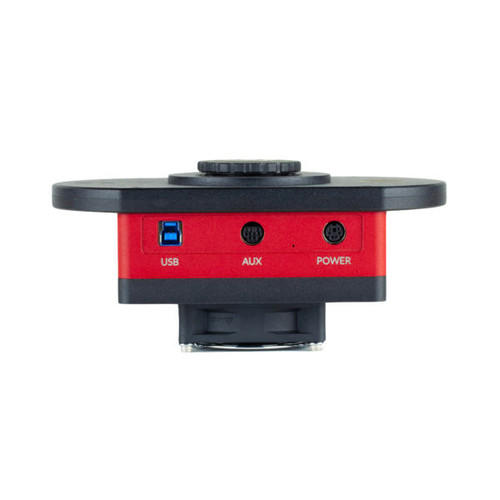Product Overview
- The world's first CMOS camera with polarization filter
- On-chip polarization filter in 4 directions in one single image
- Uses the SONY IMX250 CMOS sensor with Global Shutter Technology
- 5 MP with 2464 × 2056 pixels (8.50 mm x 7.09 mm) at a pixel size of 3.45 µm x 3.45 µm
- High frame rates of up to 68 frames per second (higher frame rates possible with ROI)
- AD conversion to 12 bit (output as 8 or 16 bit)
- Readout noise of only 2.0e-2.5e, dark current 0.005e/pixel/sec at -10 degrees Celsius
- Exposure times from 20 µs to 600 seconds
- Applications in astronomy, biology, gemstone science and materials technology
- Is also available as monochrome version without polarize (QHY550 M)
The polarizer is formed on the photodiode of the image sensor chip. In addition to capturing brightness and color the image sensor can also capture polarization information that cannot be detected by a normal image sensor. Polarsens is a Sony CMOS Image Sensor pixel technology that places polarizing filters for several different angles of polarized light on chip during the semiconductor process allowing highly accurate pixel alignment.
Polarizer is formed on chip under the on-chip lens layer
With conventional types of polarization sensors, the polarizer is attached on top of the on-chip lens layer, however with Sony Semiconductor Solutions’ polarization sensor the polarizer is formed on chip under the on-chip lens layer. A shorter distance between the polarizer and the photodiode improves the extinction ratio and the incident angle dependence. Since the polarizer is formed during the semiconductor process, form and formulation of polarizer, uniformity, mass productivity and durability are excellent compared to conventional polarization sensors. Furthermore, Sony's Polarization sensor is covered with an anti-reflection layer which helps to reduce reflectance and avoids poor flare and ghost characteristics.
Polarized Images at High Frame Rates, 67FPS @ 5.0mp
The QHY550 to capture a four-direction polarized image in one shot. It can calculate the direction and degree of polarization (DoP) based on the intensity of each directional polarization. Together with subsequent signal processing, it can capture the polarization information in real time. The QHY550 uses a USB3.0 interface. It can output 67FPS, full resolution 8-bit images. For 12-bit output it achieves 34FPS at full resolution. By selecting a region of interest (ROI) it can output hundreds of frames per second.
Global Shutter
Some applications require imaging of fast-moving objects. However, existing CMOS image sensors are often unable to accurately identify such objects due to the focal plane distortion of fast-moving objects caused by the rolling shutter function. The IMX250 address this issue by providing an analog memory inside each pixel and realizing the global shutter function to enable high-picture-quality without focal plane distortion.
Low Dark Current, 2-stage TEC cooled, Temperature Regulated
QHY550 uses a two stage TEC to cool the sensor to -35C below ambient. This can reduce the dark current of IMX250 significantly and greatly improves the dim signal detection performance. This is of benefit when detecting small differences in the polarized light in astronomical objects such as comets or the sun, in life science applications and in the optical lab.
Industrial, Gemstone and Biological Imaging

For production inspection, a polarized detector can be used to detect imperfections, scratches, etc., that might otherwise be missed. Polarized light has long been used in gemstone geology, material science and biological applications.












